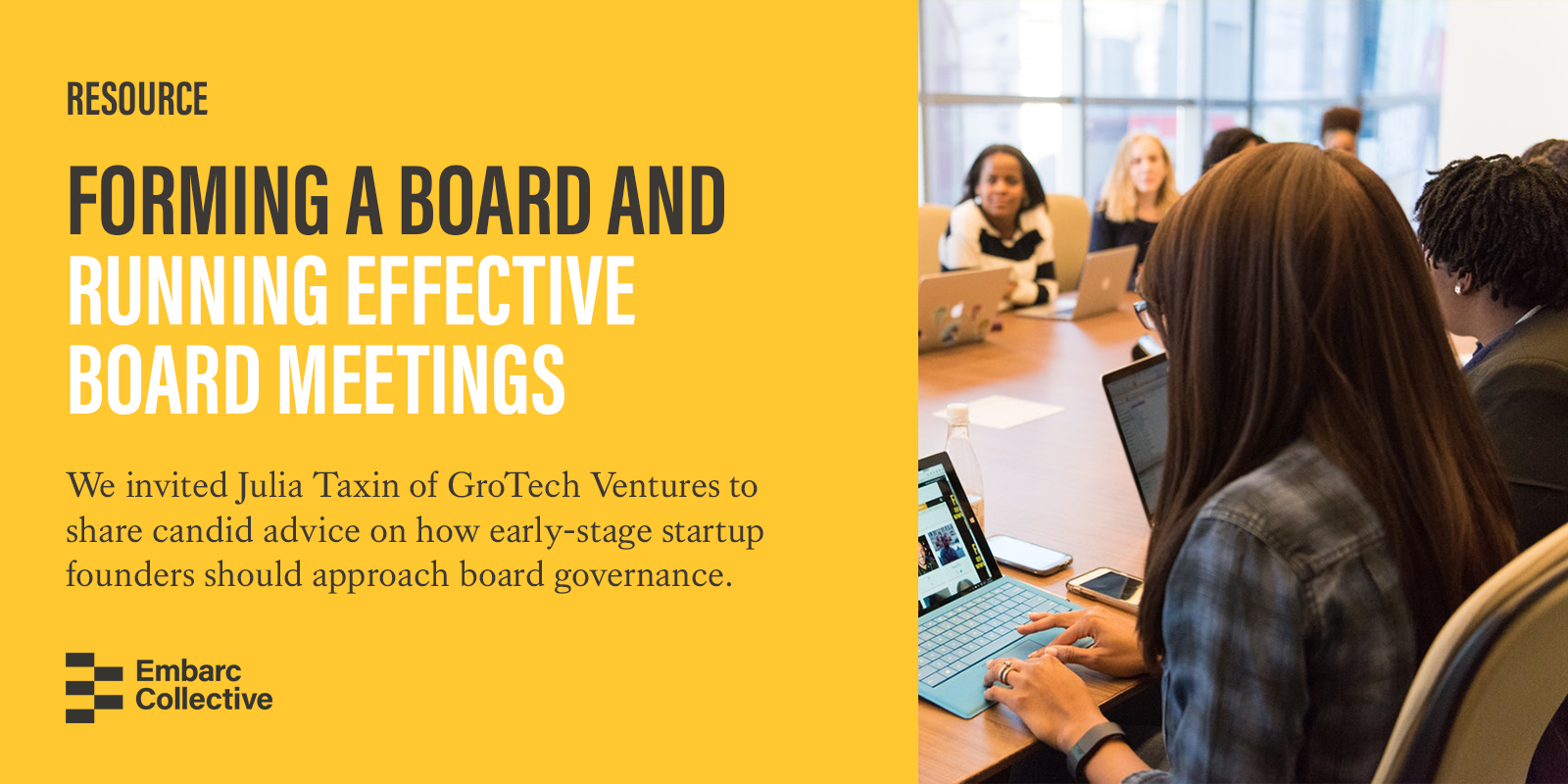Recently, we invited Julia Taxin of Grotech Ventures to share tips with Embarc Collective members on how to run an effective board meeting. In this recap, we cover Julia’s top recommendations on how to form a board and how to run effective board meetings.
Forming The Board
Don’t form a board with outside members until your startup takes on financial investment.
Prior to taking on investment, the founders are responsible for company decisions. Taxin recommends holding off on formalizing a board of directors with outside members until after an initial investment is made into the company. What Taxin recommends for companies just getting off the ground is assembling an advisory board before funding. Find value-add people in your network, investors included, who want to be helpful along the way and that aren’t tied to being involved in an official board.
Get to know investors at least 6 months before bringing them on.
Adding investors to your cap table and involving them as a board member is a long term commitment and relationship. Find the people that are really going to give you their time and will invest in you and your startup’s success. A new board member should be someone who can add value to your company, not just monetary value but strategic — this is really important.
Be upfront about your time expectations of board members.
Layout how frequently you want to hold board meetings and the amount of individual time from each member. Level setting early on is very important for expectations on both ends. That’s why the trial period of getting to know who they are and how they will be helpful to your board is important. Access to potential customer introductions, recruiting help, strategic advice and governance are all things you should expect from your board members. They may have industry expertise to help you with specific problems of your business. Make it clear that this support is what you want from your board members. Time commitment will vary from week to week, quarter to quarter depending on what is going on with the company. Taxin believes the best board-company relationships are those where there is a constant flow of communication. Board members should be available without much notice to jump on a call if there is something going on with the company. If you are not getting enough out of your board members, sit down and have an honest conversations about expectations going forward.
Until you form a board, practice as if you have one.
Train by holding board meetings with your team. Review KPIs and financials, send out quarterly summaries, and hold regular meetings with your team as if they were your board. As you meet prospective investors or board members, ask if they would like to be added to your investor list and add them to the distribution for your company summaries. Taxin typically receives 20 updates per quarter for companies she’s keeping up with. Most were formatted in the following structure:
- this is what we did this quarter
- this is what we’re doing next quarter
- these were our challenges
- Any asks you have of the recipients
Taxin suggests sending prospective investors an abbreviated version of your quarterly update without reporting detailed financials. Instead of stating numbers, show growth on a percentage basis. Same goes for the forecast for the following quarter. Expect anything that you send out to be saved and referred to later. For people that may invest, keep it salesy. For those who are on the cap table, include more details.
Leverage board observers strategically to fill gaps on your team.
Taxin says she’s seen companies optimize board observers and others not take advantage of the resource. While she believes the more the merrier in the board room, you should be mindful of what that observer can actually contribute to the meeting. Observers typically don’t weigh in all the time but it’s important to create a culture where everyone’s opinion in the board room matters. Startup founders can also leverage board observers as confidants as they don’t have the same restraints that traditional board member roles hold. Build strong relationships with board observers that are willing to listen and provide insight. She also advises that startup founders really zero in on a potential board observer’s motive for being in the room before bringing them on as they have the potential to hold a traditional board member role later down the line if it aligns with the startup.
Running Board Meetings
Give The Board Visibility to Members of Your Team
Taxin advises startups make sure board members have access to key management members. The first few board meetings after a new board member is added should include your top management team, not just the CEO. In future meetings, you can invite functional heads to give updates to the board on their specific functional area. Taxin believes specific functional updates should be lead by whoever is closest to it and in turn provides visibility to board members of the key management team members. It’s important for your team, especially in the early stages, to know who they’re working with. It’s equally as important for your board to get to know your team.
When holding meetings that invite in other team members, you can dedicate one portion of the board meeting to include them and then in the second half of the meeting, keep it exclusive to board members and the CEO to discuss strategic topics which may not be appropriate for the full team to hear.
Call On Your Team to Complete Board Updates
Ahead of the board meeting, you’ll want to prepare updates on company performance. Leverage key team leaders to help pull together the necessary data. Most startups create a powerpoint deck to share updates. The amount of update slides vary widely from company to company and from meeting to meeting, typically there are 20-25 slides with appendix at the end for more details.
Send Your Board Deck Slides Ahead of the Board Meeting
The most effective board meetings happen when the board has time to review the material ahead of the meeting. Taxin suggests giving board members at least 2 days to review the material. If any of your board members need to travel to get to you, be mindful of that as well and try to send out ahead of their travel schedule. Taxin also says a pro tip is to have a template you can edit each meeting. Documents should be added to a central place like Google Drive, Box, Dropbox or other cloud storage platforms to share with board members.
Send Follow Ups and Continue Updates After Board Meetings
CEOs should follow-up in email after the board meetings. Outlining next steps discussed in the meetings as well as any other follow up items to individual board members.
Have Counsel Attend Your Meetings
Taxin says it’s valuable to have legal counsel at your meetings. It’s oftentimes not expensive to have them there and they can help keep minutes. They are also valuable to have around for legal perspective. Board meetings do need to be formally recorded. Be sure to keep high level minutes, bullet points to focus on key moments, decisions and what the board members approved is sufficient. If you don’t have counsel, the CFO or another top management member can do it. Taxin recommends Carta get quick approvals, minutes can be recorded via word documents and sent around before the next meeting for approval.
Engage with Your Board Members Like You Would Your Team
Taxin says board dinners are great for building relationships with your board. Typically they are done the night before the board meeting. They don’t have to be expensive but it should be a sit-down experience to get everyone to connect beforehand. These dinners should be focused on relationship building, save the business talk for the board meeting the following day.
Follow Julia Taxin on Twitter and LinkedIn
To learn more about Grotech Ventures visit: https://www.grotech.com/



